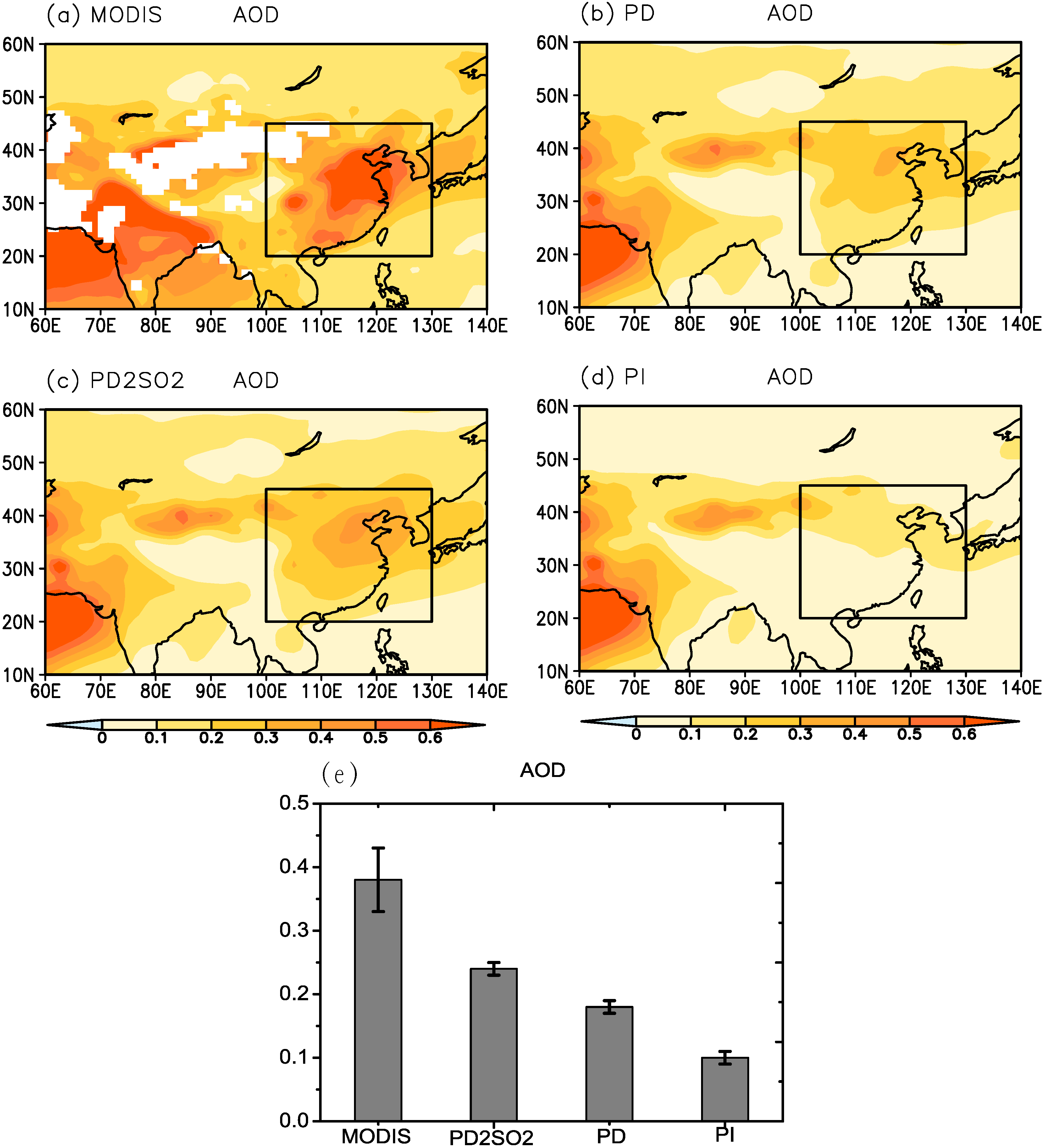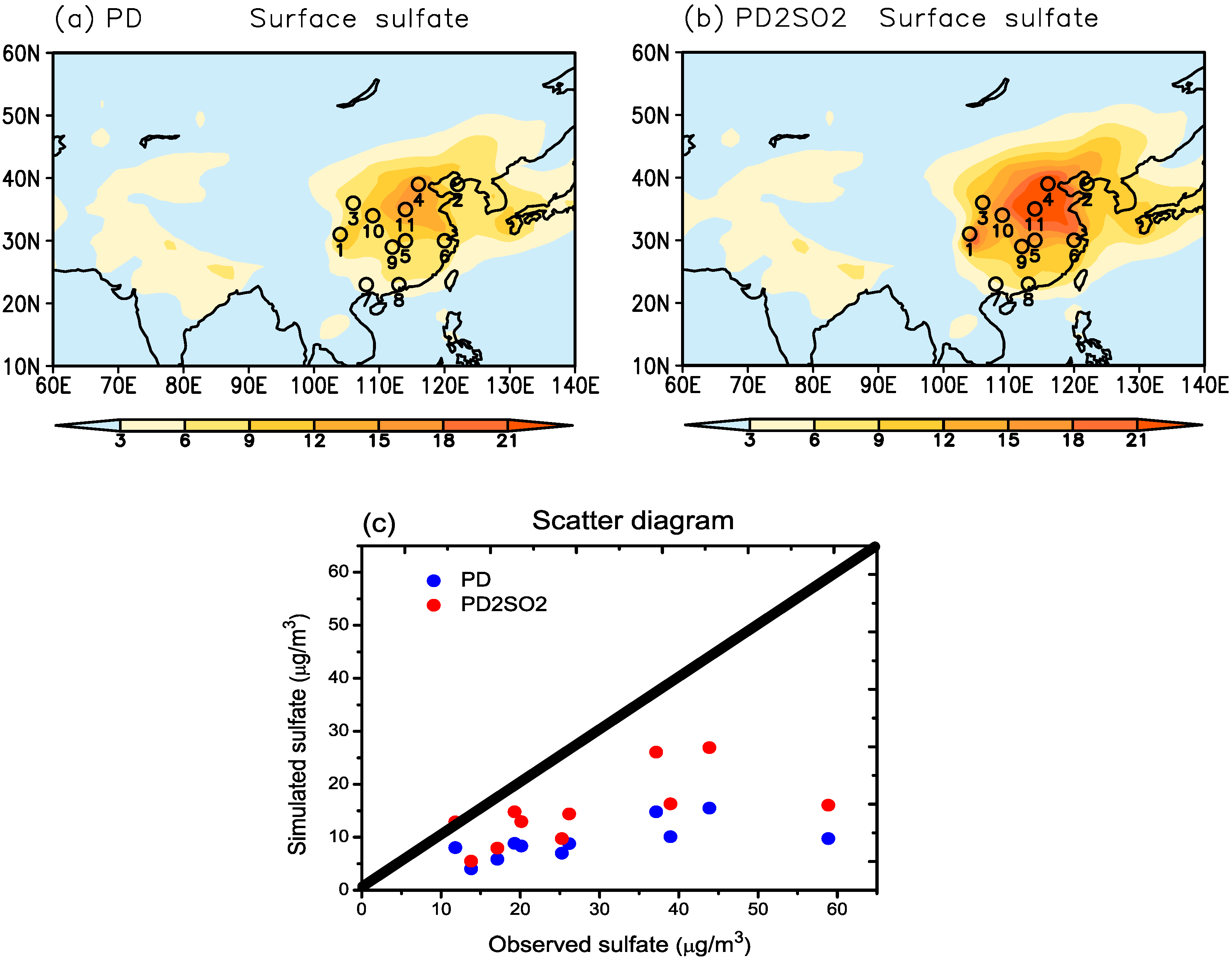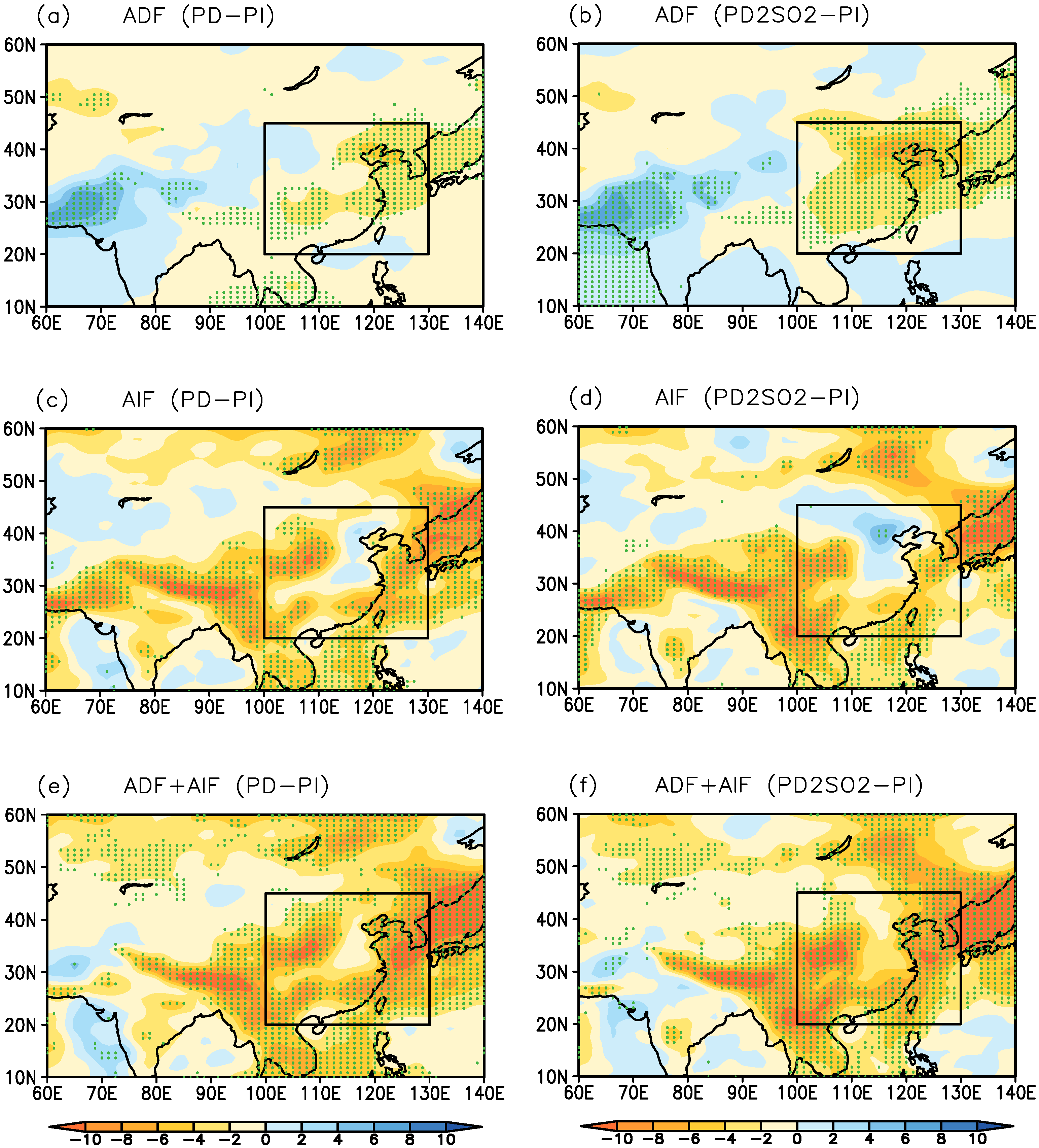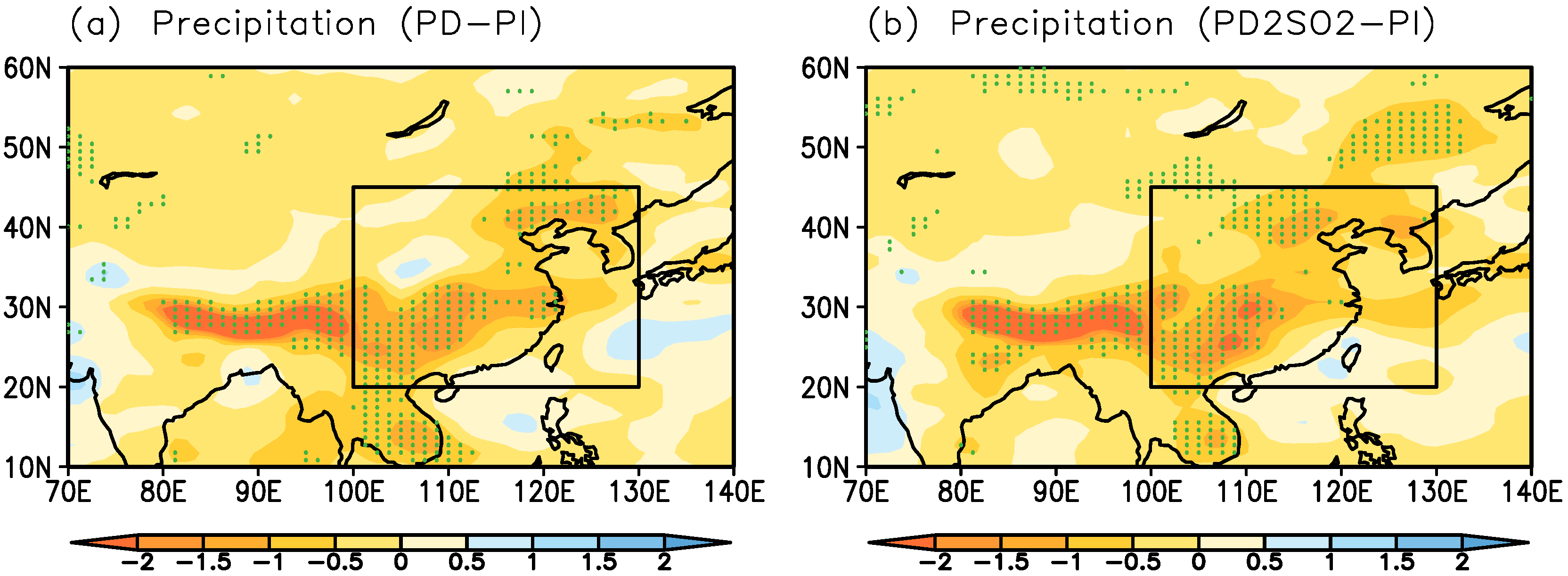Effects of Aerosols on Radiative Forcing and Climate Over East Asia With Different SO2 Emissions
Abstract
:1. Introduction
2. Model and Data
2.1. The CAM5.1 Model
2.2. Observed Data
3. Results
3.1. Comparison between Observation and Model
3.2. Aerosol Effects on Cloud Properties and Radiative Forcing
3.3. Aerosol Effects on East Asian Climate
4. Discussion
5. Conclusions
Supplementary Materials
Acknowledgments
Author Contributions
Conflicts of Interest
References
- Zhang, X.Y.; Wang, Y.Q.; Niu, T.; Zhang, X.C.; Gong, S.L.; Zhang, Y.M.; Sun, J.Y. Atmospheric aerosol compositions in China: Spatial/temporal variability, chemical signature, regional haze distribution and comparisons with global aerosols. Atmos. Chem. Phys. 2012, 12, 779–799. [Google Scholar] [CrossRef]
- Lau, K.-M.; Tsay, S.C.; Hsu, C.; Chin, M.; Ramanathan, V.; Wu, G.X.; Li, Z.; Sikka, R.; Holben, B.; Lu, B.; et al. The joint Aerosol-Monsoon experiment: A new challenge for Monsoon climate research. Bull. Am. Meteorol. Soc. 2008, 89, 369–383. [Google Scholar] [CrossRef]
- Li, Z.; Li, C.; Chen, H.; Tsay, S.-C.; Holben, B.; Huang, J.; Li, B.; Maring, H.; Qian, Y.; Shi, G.; et al. East Asian studies of tropospheric aerosols and their impact on regional climate (EASTAIRC): An overview. J. Geophys. Res. 2011, 116, D00K34. [Google Scholar]
- Wu, G.X.; Li, Z.Q.; Fu, C.B.; Zhang, X.Y.; Zhang, R.Y.; Zhang, R.H.; Zhou, T.J.; Li, J.P.; Li, J.D.; Zhou, D.G.; et al. Advances in studying interactions between aerosols and monsoon in China. Sci. China Earth Sci. 2016, 59, 1–16. [Google Scholar] [CrossRef]
- Solomon, S.; Qin, D.; Manning, M.; Chen, Z.; Marquis, M.; Averyt, K.B.; Tignor, M.; Miller, H.L. IPCC, 2007: Climate change 2007: The Physical Science Basis. Contribution of Working Group I to the Fourth Assessment Report of the Intergovernmental Panel on Climate Change; Cambridge University Press: Cambridge, UK; New York, NY, USA, 2007. [Google Scholar]
- Stocker, T.F.; Qin, D.; Plattner, G.-K.; Tignor, M.; Allen, S.K.; Boschung, J.; Nauels, A.; Xia, Y.; Bex, V. (Eds.) IPCC, 2013: Climate change 2013: The Physical Science Basis. Contribution of Working Group I to the fifth assessment report of the Intergovernmental Panel on Climate Change; Cambridge University Press: Cambridge, UK; New York, NY, USA, 2013.
- Twomey, S.A. The influence of pollution on the shortwave albedo of clouds. J. Atmos. Sci. 1977, l34, 1149–1152. [Google Scholar] [CrossRef]
- Albrecht, B.A. Aerosols, cloud microphysics and fractional cloudiness. Science 1989, 245, 1227–1230. [Google Scholar] [CrossRef] [PubMed]
- Ramanathan, V.; Crutzen, P.J.; Kiehl, J.T.; Rosenfeld, D. Aerosols, climate, and the hydrological cycle. Science 2001, 294, 2119–2124. [Google Scholar] [CrossRef] [PubMed]
- Meehl, G.A.; Arblaster, J.M.; Collins, W.D. Effects of black carbon aerosols on the Indian monsoon. J. Clim. 2008, 21, 2869–2882. [Google Scholar] [CrossRef]
- Bollasina, M.A.; Ming, Y.; Ramaswamy, V. Anthropogenic aerosols and the weakening of the South Asian summer monsoon. Science 2011, 334, 502–505. [Google Scholar] [CrossRef] [PubMed]
- Menon, S.; Hansen, J.; Nazarenko, L.; Luo, Y.F. Climate effects of black carbon aerosols in China and India. Science 2002, 297, 2250–2253. [Google Scholar] [CrossRef] [PubMed]
- Liu, X.D.; Xie, X.N.; Yin, Z.-Y.; Liu, C.H.; Gettelman, A. A modeling study of the effects of aerosols on clouds and precipitation over East Asia. Theor. Appl. Climatol. 2011, 106, 343–354. [Google Scholar] [CrossRef]
- Jiang, Y.; Liu, X.; Yang, X.-Q.; Wang, M. A numerical study of the effect of different aerosol types on East Asian summer clouds and precipitation. Atmos. Environ. 2013, 70, 51–63. [Google Scholar] [CrossRef]
- Wang, H.L.; Xie, X.N.; Liu, X.D. On the robustness of the weakening effect of anthropogenic aerosols on the East Asian summer monsoon with multimodel results. Adv. Meteorol. 2015, 2015, 397395. [Google Scholar] [CrossRef]
- Wang, T.J.; Zhuang, B.L.; Li, S.; Liu, J.; Xie, M.; Yin, C.Q.; Zhang, Y.; Yuan, C.; Zhu, J.L.; Ji, L.Q.; et al. The interactions between anthropogenic aerosols and the East Asian summer monsoon using RegCCMS. J. Geophys. Res. Atmos. 2015, 120, 5602–5621. [Google Scholar] [CrossRef]
- Li, S.; Wang, T.; Solmon, F.; Zhuang, B.; Wu, H.; Xie, M.; Han, Y.; Wang, X. Impact of aerosols on regional climate in southern and northern China during strong/weak East Asian summer monsoon years. J. Geophys. Res. Atmos. 2016, 121, 4069–4081. [Google Scholar] [CrossRef]
- Xie, X.N.; Wang, H.L.; Liu, X.D.; Li, J.D.; Wang, Z.S.; Liu, Y.G. Distinct effects of anthropogenic aerosols on the East Asian summer monsoon between multi-decadal strong and weak monsoon stages. J. Geophys. Res. Atmos. 2016, 121, 7026–7040. [Google Scholar] [CrossRef]
- Cao, G.L.; Zhang, X.Y.; Gong, S.L.; An, X.; Wang, Y. Emission inventories of primary particles and pollutant gases for China. Chin. Sci. Bull. 2011, 56, 781–788. [Google Scholar] [CrossRef]
- Liu, X.; Easter, R.C.; Ghan, S.J.; Zaveri, R.; Rasch, P.; Shi, X.; Lamarque, J.-F.; Gettelman, A.; Morrison, H.; Vitt, F.; et al. Towards a minimal representation of aerosol direct and indirect effects: Model description and evaluation. Geosci. Model Dev. 2012, 5, 709–735. [Google Scholar] [CrossRef]
- Neale, R.B.; Chen, C.-C.; Gettelman, A.; Lauritzen, P.H.; Park, S.; Williamson, D.L.; Conley, A.J.; Garcia, R.; Kinnison, D.; Lamarque, J.-F.; et al. Description of the NCAR Community Atmosphere Model (CAM5.0); NCAR/TN-486 + STR; National Center for Atmospheric Research: Boulder, CO, USA, 2010. [Google Scholar]
- Morrison, H.; Gettelman, A. A new two-moment bulk stratiform cloud microphysics scheme in the NCAR Community Atmosphere Model (CAM3), Part I: Description and numerical tests. J. Clim. 2008, 21, 3642–3659. [Google Scholar] [CrossRef]
- Ghan, S.J.; Liu, X.; Easter, R.C.; Zaveri, R.; Rasch, P.J.; Yoon, J.H.; Eaton, B. Toward a minimal representation of aerosols in climate models: Comparative decomposition of aerosol direct, semidirect, and indirect radiative forcing. J. Clim. 2012, 25, 6461–6476. [Google Scholar] [CrossRef]
- Ghan, S.J. Technical note: Estimating aerosol effects on cloud radiative forcing. Atmos. Chem. Phys. 2012, 13, 9971–9974. [Google Scholar]
- Ma, P.-L.; Rasch, P.J.; Wang, M.; Wang, H.; Ghan, S.J.; Easter, R.C.; Gustafson, W.I., Jr.; Liu, X.; Zhang, Y.; Ma, H.-Y. How does increasing horizontal resolution in a global climate model improve the simulation of aerosol-cloud interactions? Geophys. Res. Lett. 2015, 42, 5058–5065. [Google Scholar] [CrossRef]
- Kaufman, Y.J.; Tanré, D.; Remer, L.A.; Vermote, E.F.; Chu, A.; Holben, B.N. Operational remote sensing of tropospheric aerosol over land from EOS moderate resolution imaging spectroradiometer. J. Geophys. Res. 1997, 102, 17051–17067. [Google Scholar] [CrossRef]
- Xie, X.N.; Liu, X.D.; Peng, Y.; Wang, Y.; Yue, Z.G.; Li, X.Z. Numerical simulation of clouds and precipitation depending on different relationships between aerosol and cloud droplet spectral dispersion. Tellus B 2013, 65, 19054. [Google Scholar] [CrossRef]
- Ganguly, D.; Rasch, P.J.; Wang, H.; Yoon, J.-H. Fast and slow responses of the South Asian monsoon system to anthropogenic aerosols. Geophys. Res. Lett. 2012, 39, L18804. [Google Scholar] [CrossRef]






| PI | PD−PI | PD2SO2−PI | |
|---|---|---|---|
| LWP (g·m) | 77.10 | 20.90 * | 22.35 * |
| CDNUMC ( cm) | 1.29 | 2.49 * | 2.81 * |
| RE (m) | 10.01 | −1.39 * | −1.51 * |
| CLDLOW (%) | 29.39 | 0.23 | 0.06 |
| CLDMED (%) | 25.76 | 0.04 | −0.14 |
| CLDHGH (%) | 58.30 | −1.63 | −0.97 |
| CLDTOT (%) | 68.33 | −0.90 | −0.53 |
| WVF (kg·m·s) | 180.25 | −14.19 * | −14.65 * |
| WVFC (10 kg·m·s) | −3.68 | 0.55 * | 0.58 * |
| OMEGA (0.01 × Pa·s) | −2.56 | 0.40 * | 0.45 * |
| PI | PD−PI | PD2SO2−PI | |
|---|---|---|---|
| TS () | 25.40 | −0.35 | −0.37 |
| SLP (hPa) | 1005.49 | 0.43 | 0.45 |
| EASMI (m·s) | 4.42 | −0.41(−9.3%) | −0.43(−9.7%) |
| PRECT (mm·day ) | 5.74 | −0.54(−9.3%) | −0.61(−10.7%) |
© 2016 by the authors; licensee MDPI, Basel, Switzerland. This article is an open access article distributed under the terms and conditions of the Creative Commons Attribution (CC-BY) license (http://creativecommons.org/licenses/by/4.0/).
Share and Cite
Xie, X.; Liu, X.; Wang, H.; Wang, Z. Effects of Aerosols on Radiative Forcing and Climate Over East Asia With Different SO2 Emissions. Atmosphere 2016, 7, 99. https://doi.org/10.3390/atmos7080099
Xie X, Liu X, Wang H, Wang Z. Effects of Aerosols on Radiative Forcing and Climate Over East Asia With Different SO2 Emissions. Atmosphere. 2016; 7(8):99. https://doi.org/10.3390/atmos7080099
Chicago/Turabian StyleXie, Xiaoning, Xiaodong Liu, Hongli Wang, and Zhaosheng Wang. 2016. "Effects of Aerosols on Radiative Forcing and Climate Over East Asia With Different SO2 Emissions" Atmosphere 7, no. 8: 99. https://doi.org/10.3390/atmos7080099
APA StyleXie, X., Liu, X., Wang, H., & Wang, Z. (2016). Effects of Aerosols on Radiative Forcing and Climate Over East Asia With Different SO2 Emissions. Atmosphere, 7(8), 99. https://doi.org/10.3390/atmos7080099








